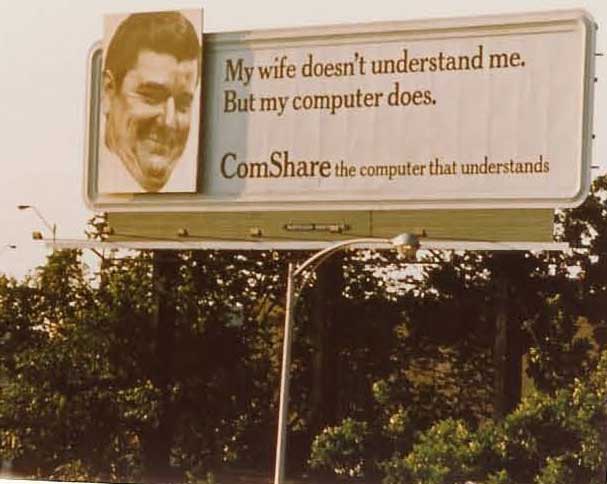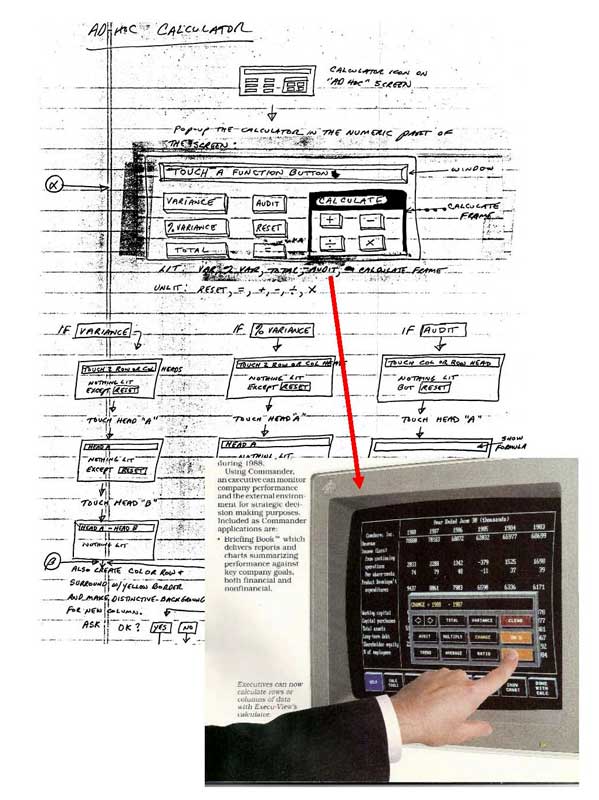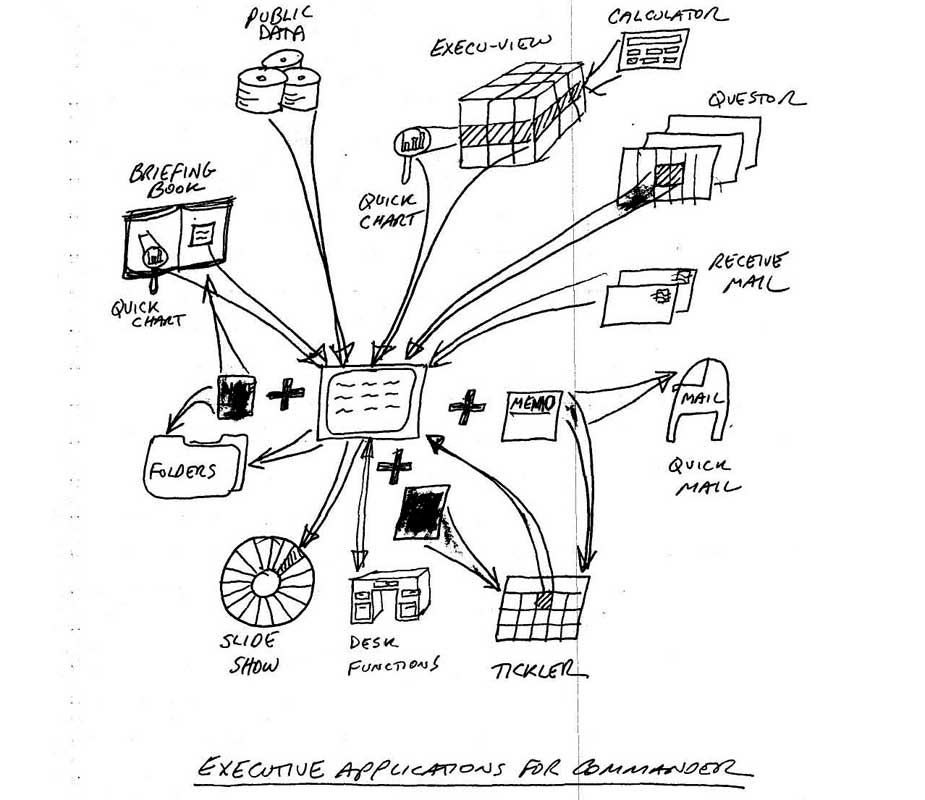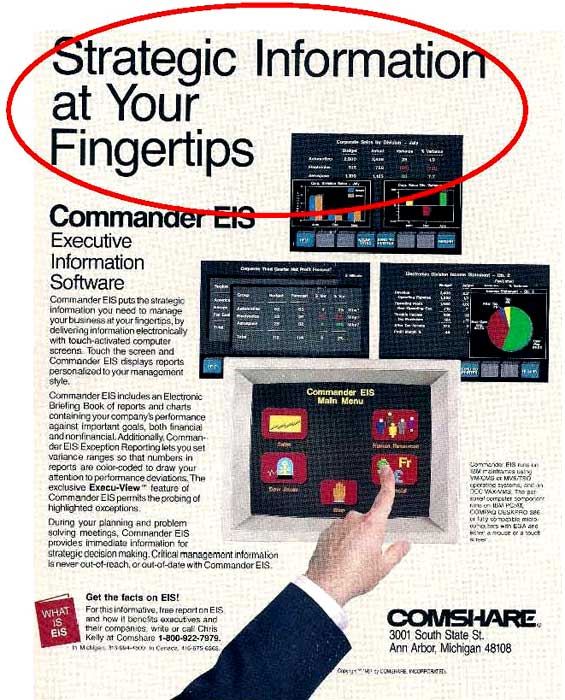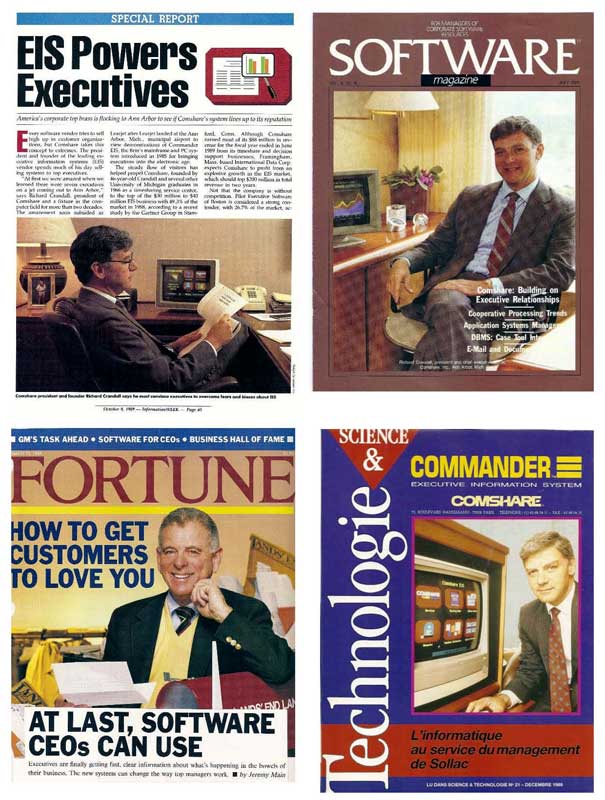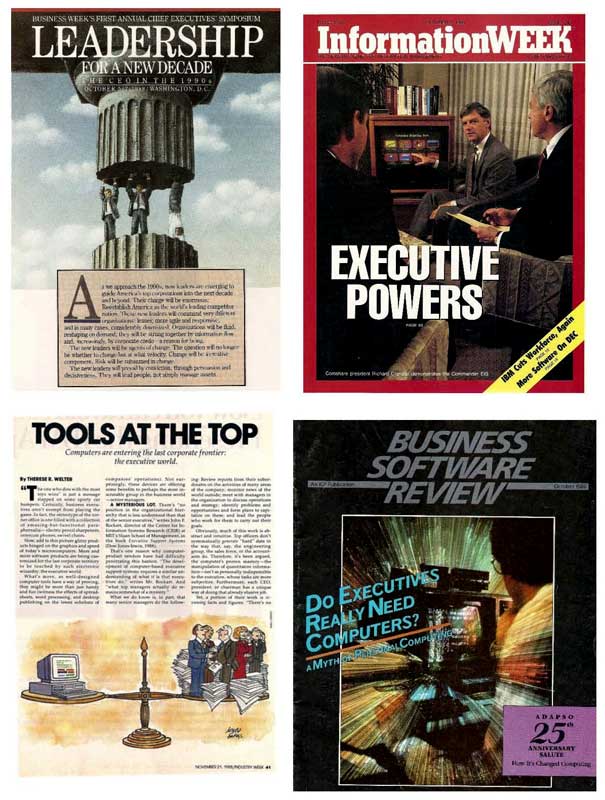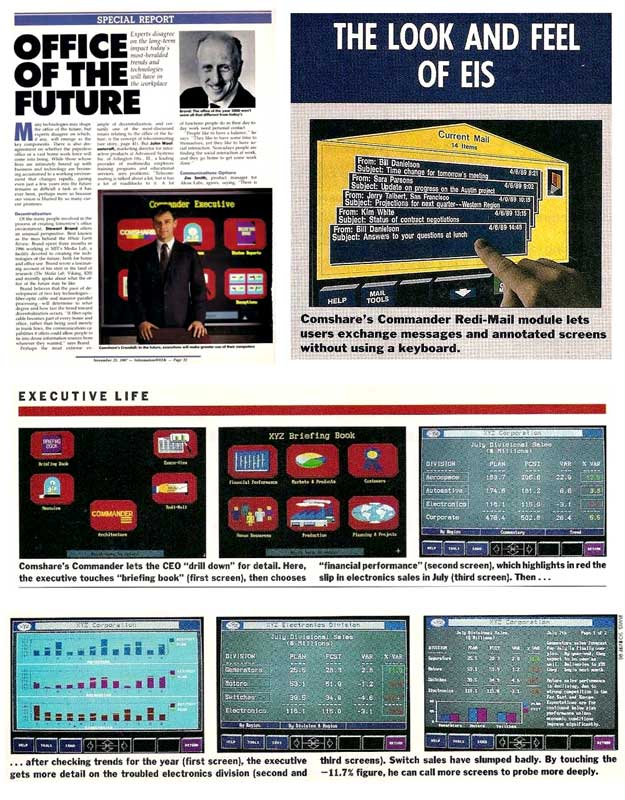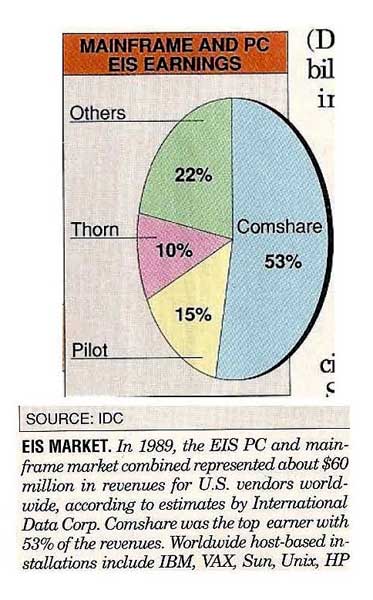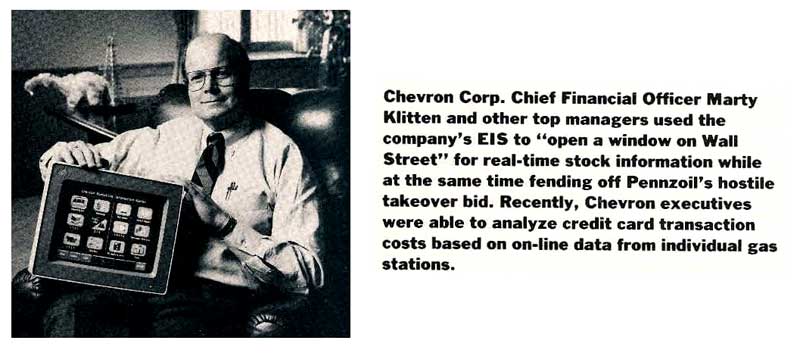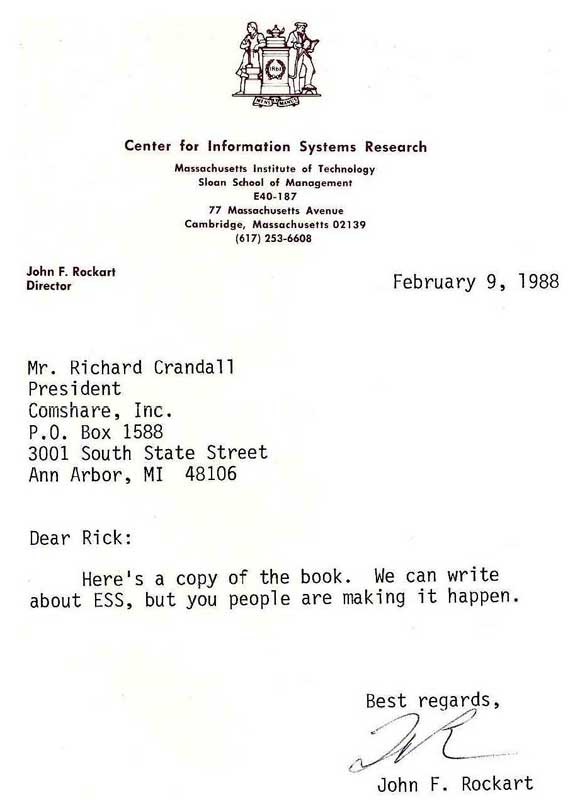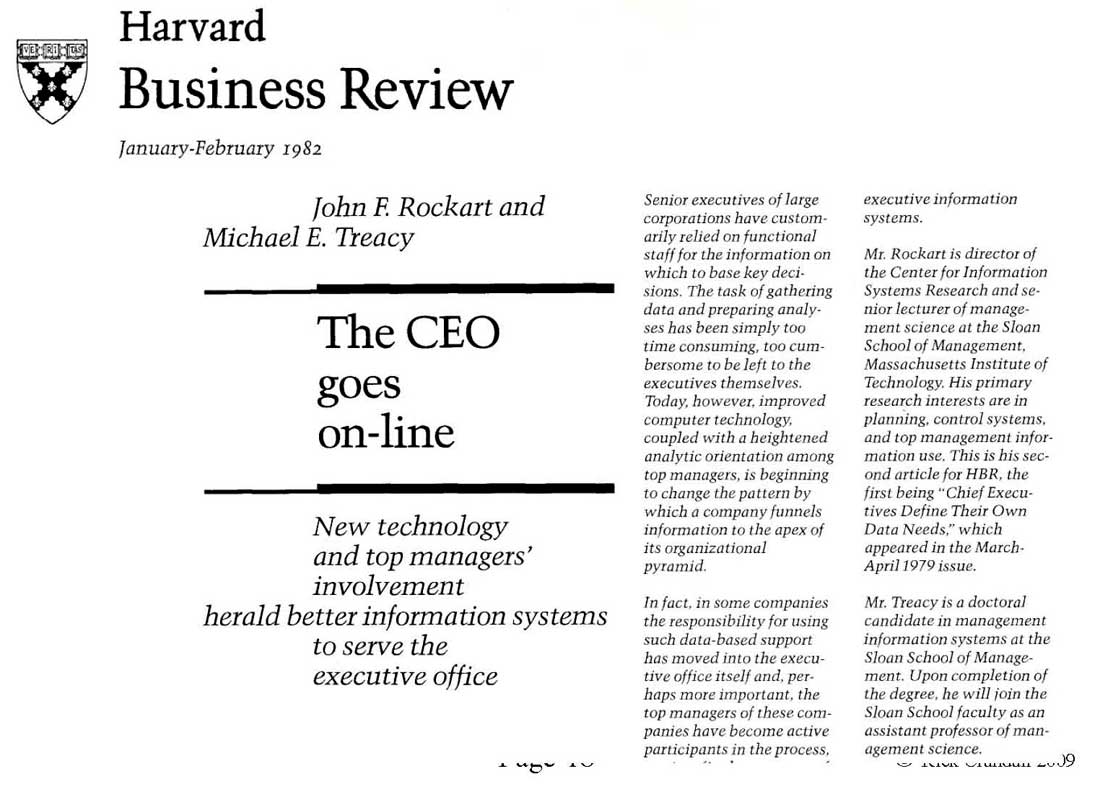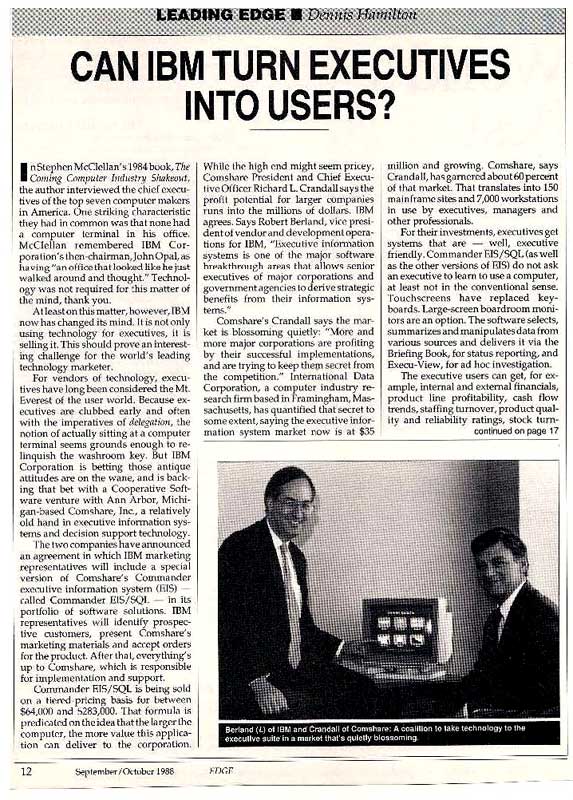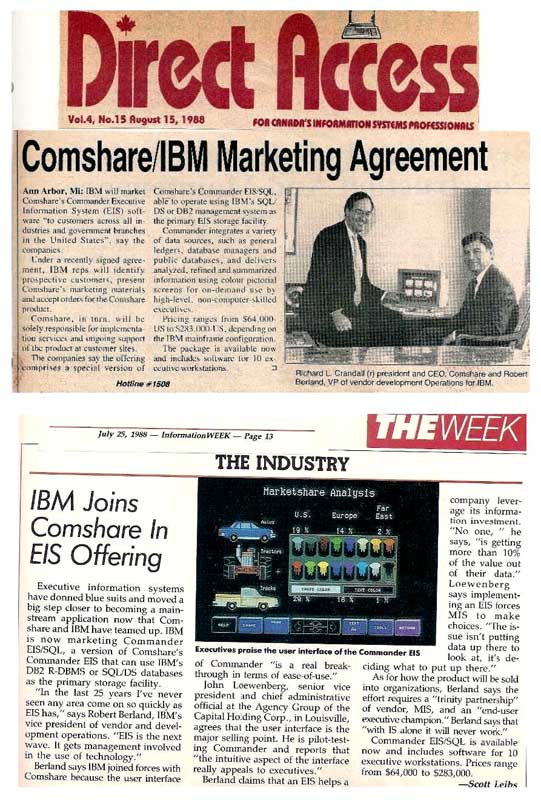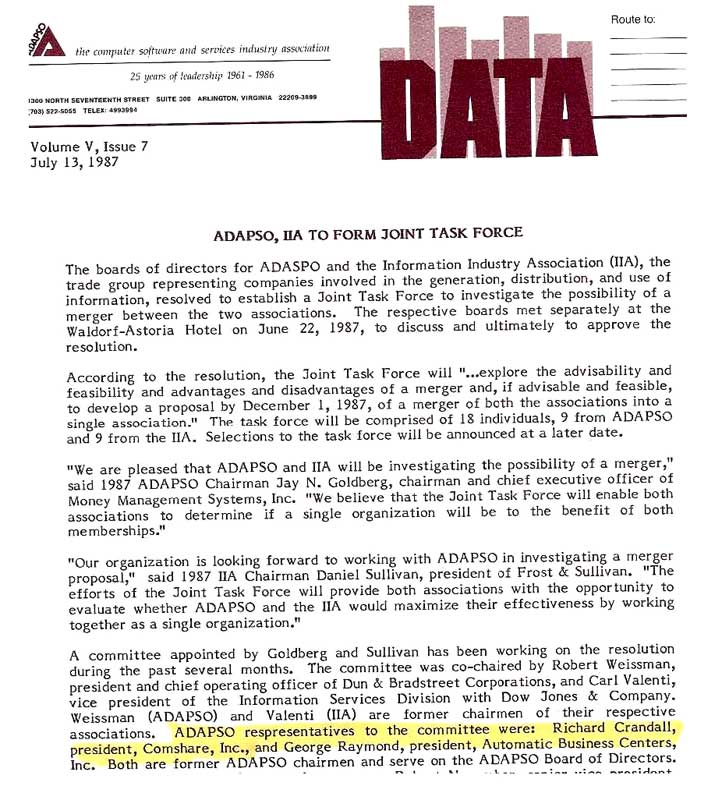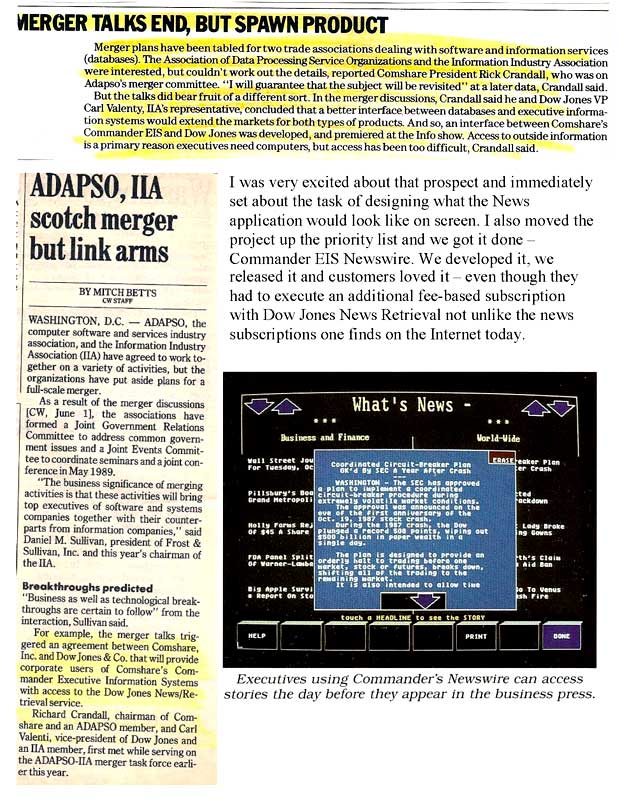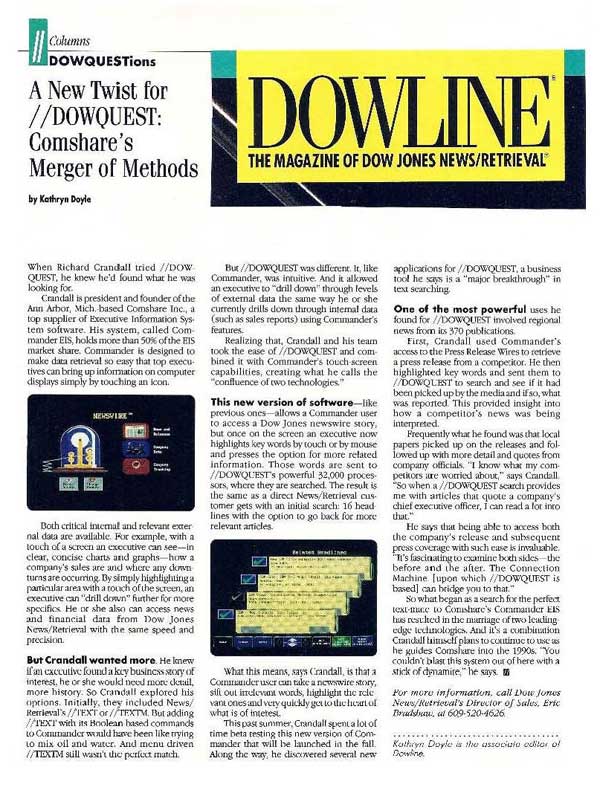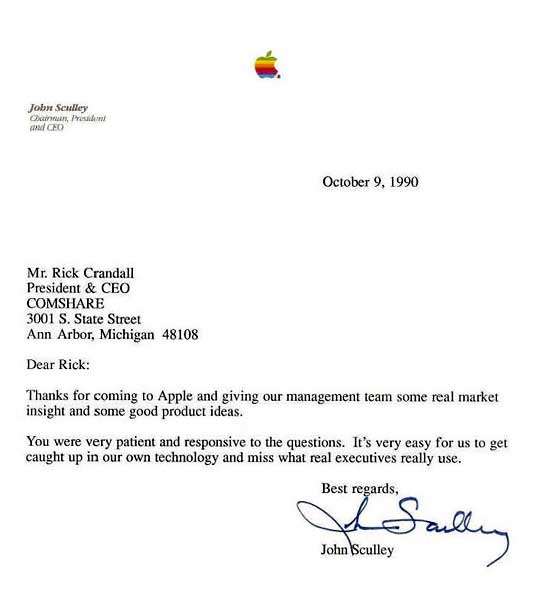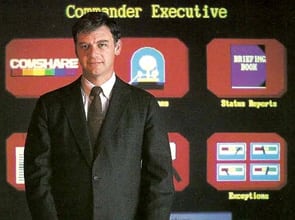
© 2009 By Rick Crandall
Executive Information Systems (EIS) became an improbable but explosively accepted new software category in the mid-1980’s made possible by the confluence of new graphical human factors, the mouse and touch-screen, the IBM PC and the passion of a few entrepreneurial zealots, one of which was Yours Truly. The story of how this product and market came about is not unique. In fact it is undoubtedly typical of most successful new product categories. I’ll tell the Comshare EIS story here, with plenty of emails and press articles as substantiation that make the recollections real and not just the imperfect memory of a 25 year old phenomenon.
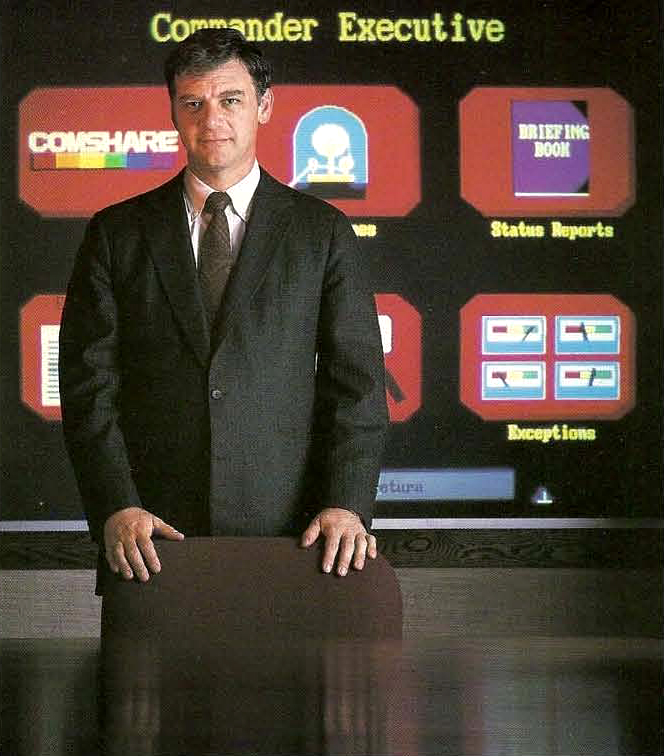
Elsewhere the story of the founding of Comshare is documented in some detail (see www.aspenventure.com and click on IEEE Annals History of Computing). The company was born of typical American entrepreneurial spirit, mixed with serendipity, naïveté, passion and the vision of a few. I was surely not the only one to target the non-technical executive as a user, but I am sure I was one of the earliest.
This drive was born of my early experiences with making timesharing an accepted technology and service truly designed for end users. Its interactivity as opposed to batch processing computing, combined with an early focus on human factors never before considered seriously in computing applications, became almost a religion among those who created the timesharing industry. Great credit must be given to the early efforts at U. California Berkeley, MIT, University of Michigan, and Dartmouth University for laying the groundwork for interactive computing that was then commercialized by the likes of Comshare, Tymshare, General Electric, NCSS and others.
The early users of timesharing are well-documented – they were the scientific and engineering community who had the technical orientation to put up with the imperfections in the software and the frequent system crashes in the early days. They saw and revered the benefits of interactive computing on developer productivity and how it reduced elapsed cycle-time to get a project completed.
That was in the 1965 – 1969 period. Then the recession of 1970 hit – which many called the “aerospace recession” but it went beyond that – many engineers of all kinds lost their jobs, and they were a huge part of the early timesharing customer base.
The timesharing companies at the time were forced to revisit their strategies, which turned out to have a silver lining for some. Comshare refocused its efforts towards applied uses of timesharing that would appeal to the business and financial user, moving away from its engineering-user heritage. That change in strategy led us to offering financial modeling – actually an on-line predecessor to spreadsheet software.
Human factors were still dictated by the terminals that were most popular in use with timesharing systems – namely the character-oriented Teletypes made by Teletype Corporation. No graphics, no screens yet, just characters on a page. The most exciting thing you could find that had anything to do with graphics were the elaborate multi-page images that clever programmers would create (around Christmas time) of Santa and his eight reindeer made of pages full of characters printed much like embroidery patterns.
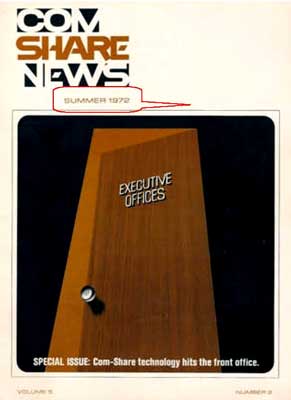
I definitely had the “serve-the-end-user” fever. I had fully bought into the idea that true differentiation and leverage in the market could be gotten by serving the un-served. In the early days of timesharing that meant serving the real end user and skipping around the data processing organization. However, as timesharing companies proliferated like bunnies on a farm, I found myself searching for end-user populations that were even un-served by timesharing
Our sales force, undoubtedly like most, claimed that when they made sales calls that they “sold high” meaning they got to high-level decision makers. Deeper inspection always proved these were hollow claims. Somewhere in the 1972 to 1974 period I began to ‘hallucinate” about how great it would be if we could come up with a product that the very executives we wanted our sales force to call on, would want to use themselves.
As I thought this through, it was clear to me that to appeal to high-level executives the application would need to be financial – every manager has goals they need to achieve and even then in the 1970’s there were plenty of management teams that had a component of performance-oriented compensation. We certainly had the financial modeling software that was rule-based and in which we could capture highly personalized metrics of performance – for strategic planning, tactical performance monitoring and executive compensation schemes. But the outputs in those days were numbers and text on Teletype paper – and similar images on the early CRT screens.
It was then in the mid-1970’s that I became convinced that the way to capture the attention of the executive was to add graphics to our products, although there was still the keyboard to deal with. The keyboard was a real barrier in those days for the 50+ year-old corporate executive. A more graphical interface was a concept that in reality, given hardware limitations, it was unclear how to implement. Firstly I was very convinced from my own usage (of expensive graphic artist-based graphics) that the presentation of information graphically was highly sensitive to the graph forms. They also needed new media printing devices to produce hard copy graphic output without engaging expensive and time-consuming graphic artists.
A Graphics Terminal?
So somewhere around 1976 – 77 I did two things: 1) I figured I was an “executive’ and therefore in the targeted audience so I spent lots of time discovering which chart forms were most communicative of various performance metrics in Comshare. I also surveyed the charts used in business magazines. While we were much smaller than the Fortune 500 companies we wished to serve, I didn’t think the issues were all that different – they just had a bunch of extra zeroes tacked on the end (i.e. $ billions instead of $ millions); and 2) I tasked a staff person to figure out how to assemble a color graphical terminal that had a color CRT and a hidden slide-maker.
The result was comical. Together we created a console that had a visible CRT on which a user could create and see a chart, and hidden below was another smaller CRT with a motorized camera that would take pictures off that screen as a way of producing slides. Of course I wanted immediate gratification, and so I travelled to Polaroid Corporation in 1977 to present my idea and to attempt to talk them into making an instant-slide version of their Polaroid camera. In those days Polaroid was a star company but they only made cameras with instant in-camera processing of print images; no slides.
I created all kinds of wild forecasts for them (isn’t that what an entrepreneur does?) and some of the mid-level people actually got excited. But at the end of the day they didn’t fund the project and so I was back to the drawing boards as to how to create an executive “graphic’ product.
I suspect that if one interviewed any of my management team from the late 1970’s they would probably recall my passion for graphics in our products and would liken me to Don Quixote jousting at windmills, but I was not to be diverted. In fact this brings up one of my philosophies of life – “if you want something to happen, create a clear vision of what it is, open your mind to everything and anything that moves you in that direction, and don’t let anyone or anything distract you from the vision.” You have only to ask my wife Pamela about that and you’d get an emphatic confirmation.
Even if you don’t know how to go about your vision, if you get out into the world, expose yourself to as much as you can and then rely upon your “mental filters” to recognize the opportunities to achieve the vision. There is definitely a metaphysical element to this belief – i.e. by your very mental commitment to an outcome you can manifest it.
So now we get to where I have memos which commemorate what I’m talking about:
August 25, 1978 R. Crandall Memo to Comshare Management:
Re: Corporate Graphics Project
“I have become very committed to the idea that this is the year Comshare must make a big step in finished quality graphics for financial applications. Events are moving very rapidly with the equipment technology …
“We have a unique vantage point that we can put to profitable use by moving effectively and rapidly toward the objective of leapfrogging the current state-of-the-art in computer graphics and in so doing we add a unique value to various of our products.
“Purpose: To produce a graphics product that is operable by traditional occupants of the executive office with no technical assistance …interfaces initially with Questor and FCS … eventually with all pertinent Comshare products in a manner which achieves a breakthrough in over-all ease-of-use.
“Corporate performance reporting will be the prototype product use.”
Attachment: Article on Xerox and the Future, Government Examines Experimental Xerox Office of the Future.
“It was a hush-hush operation. Even the secret service got in on the act …orchestrated by Xerox which has been quietly working on the office of the future … White House and Congress installed Xerox’s innovative office information system… Developed at the Xerox Palo Alto Research Center … performs word processing, electronic messaging … printing, filing and document distribution. Centered around a workstation that PARC researchers Code named Alto … being used by the White House on an R&D basis for word processing and text editing. It’s also being used in interactive graphics experiments, creating such graphical products as statistical tables and charts…”
— Linda Flato
Well in what may be TMI (i.e. Too Much Information) I was dating Linda Flato, the Washington reporter who was the author of the article, and she knew of my passion for graphics. She called me to bring my attention to what was going on at the White House. She was convincing that I had to see it and to see how it might figure into our plans.
I began to explore where in Xerox this might be originating. Fortunately by that time Xerox had acquired Scientific Data Systems which was the supplier of our SDS 940 and Sigma 9 computers we were using for timesharing. Some of the SDS executives had been retained by Xerox in the non-copier areas. That gave me an in to probe what this Alto project was all about. Note the following email.
September 11, 1978 R. Crandall Memo to Comshare Management
Re: Intelligence Concerning Graphics
“…. A recent article indicated that Xerox is experimenting with an “office of the future” at the White House. It includes color graphics and the Xerox 6500 color copier. Apparently the system was developed at PARC. I noticed that Bob Spinrad (used to be SDS manager of software) just became director of that Center. I’m trying to get in touch with him to see what’s doing.”
The PARC Epiphany
I finally got through to Bob Adams, who was originally an executive from SDS but at the time I called, he was Vice President of Advance Product Marketing for Xerox. On the call, I was guilty of perhaps typical entrepreneurial exaggeration by declaring to him that we had an advanced graphical project underway at Comshare that overlapped some of what I heard was work going on at PARC. This wasn’t totally false since we actually did have an effort in the form of my chasing around the country looking at graphics products and real business uses of graph forms. I asserted that Xerox and Comshare would do well to match notes on what we were doing and that I was going to be in his neck of the woods in the near future.
My visit to PARC was certainly a company-changing experience – and life-changing for me too. They took me to the prototype of their Alto workstation and surrounded me with just the right people to explain what it was.
Jim Campbell –
V.P. Advanced Business Products
Jim Kyle – V.P. Planning
Walt Menetry –
Xerox Development Corp.
Bob Adams –
V.P. Advanced Product Marketing
I was so taken with what they were showing me, that I’ll make an admission here – I feigned a queasy stomach from some food the prior evening (not likely as I’d had dinner with President Ford and he was fine, but they didn’t know that), and used that as an excuse as to why I had to go to the bathroom every ten minutes or so. Each time in the bathroom I took out pen and notepaper and wrote observations and drew pictures of the screens I was seeing so that I wouldn’t forget them
On the plane on the way back to Ann Arbor I created the following memo from my notes. As far as I was concerned I had been given a look into the crystal ball and I saw the future. I became immediately determined that we were going to be part of it and nothing was going to stop us, despite those who knew me rolling their eyes thinking:
“Rick is off on another mission again ..”
Given how prominently the PARC effort figures in so many innovative products, including the Apple Lisa and Macintosh and Microsoft Windows, the memo I wrote undoubtedly has some historical significance.
Here is the memo I wrote:
October 16, 1978 R. Crandall Memo to Top Comshare Management
Re: Heavy Human Factors Code
“You all know that I’ve been trying to chase down any external code we can find that would add to our knowledge of human factors – particularly as they relate to ease-of-use in graphics and reporting. Well these efforts have finally struck a vein of gold – located at the Xerox PARC in conjunction with Xerox Development Corporation which is a small 15 man development corporation that actually reports directly to Peter McCullough, the Xerox CEO.
The Altos Project
“They have employed some psychologists, some industrial automation people and they’ve been given carte blanche with the goal of guess what? Producing a breakthrough in ease-of-use in Office Systems!
“They have made some impressive progress … with each of the following five targets:
1. The Executive
2. The Manager
3. The Professional Staff
4. The Personal Secretary
5. The Clerk
“Note the similarity to our targets (The Executive/Manager and the professional staff).
“The following notes describe my inferences and observations from what I saw and heard. This information must be kept confidential. I promised confidentiality and if we maintain credibility now we may even become a test site for a whole “office of the future” package.
The Mouse
“Xerox has already gone through some of the research that Batelle (Batelle Memorial Labs) was going to do for us – they looked at the keyboard, the light pen, the touch screen, the Rand tablet, etc. and they have concluded that the best input method is a combination of the keyboard (for data entry) and the “mouse” for commands.
For those of you who don’t know what a mouse is, it’s a little smaller than a cigarette pack lying on its broadest side, with three buttons on top and some bearings to glide on underneath. It is wired to the terminal screen and any two-dimensional motion you make with it will move a little arrow in exactly that direction on the screen.
“The real advantage is that it is amazingly precise and you never have to look at the mouse – you can keep your eyes on the screen. In effect the mouse is an ideal combination of a precise and fast moving cursor with a three function key pad. I was immediately sold on the idea.
Local File Storage
“The Xerox device also is a simple data management system as far as local (to the terminal) files are concerned. Down on the bottom of the screen there is a picture of a file cabinet (amongst other pictures I’ll explain later). If you touch the file drawer with the arrow, you get a display of the subject names of every folder in the drawer. If you touch one of the names, you get a list of headings of each document in the folder. Finally if you touch a heading, you get the document itself on the screen.
“In effect you have a four level storage structure without even using a file name or without ever using a real command. You can sort the documents and move them around in the cabinet just by using the ubiquitous little arrow.
Icons
“The bottom of the screen has some pictures of various printer types and all you have to do to get hard copy is touch the right device with the arrow. Still no commands. Occasionally when there are options, they flash up a row of choices that you can touch with the arrow.
“You can design your own forms by using the mouse to move lines around until you’ve got the grid you want, then you touch the calculator option and a calculator pad shows up on a part of the screen … if a field is to be calculated by the form rather than input from the user, you can refer to other fields with symbols (A1, B2, etc. ) and then define the math operations by “arrowing” the calculator symbols. These rules then become part of the form.
WYSIWYG (What You See is What You Get)
“When you are done you have not only described the appearance of the form but the data entry rules and the calculation rules that go with it. It’s a neat implementation of Dataform, again with no typed commands. To format a report you merely touch the part of the report that needs moving, push one of the mouse buttons to indicate “attach”, and then move the mouse which moves that section of the report.
“Other Nifty Items
Another of the bottom pictures is a mailbox. If you address a letter and “drop” it in the mailbox with the arrow, it is sent, via Fax immediately. You can select many fonts easier than changing an IBM golf ball and you can store photos in a fine dot matrix (with the resolution of a newspaper photo). The screen is high resolution (80 lines/inch) and the local storage media can handle the picture dot matrix along with the text.
“Obviously a document can have a graph but you have to build the graph with the arrow. This is interesting but is a real weakness in the system. They’ve not thought through the graphics and were very interested in our work. They have no plans to add color to this device although they have some fascinating color printers as followers to the 6500.
“This kind of work will be the technology of the 1980’s – and the really successful way to put DDP in the hands of the end user.
I felt like Moses must have felt returning from the Mount. I had seen the “tablets” that described how the world was going to be in the future. I made a personal commitment that Comshare was going to be a part of that future. This came at a time when we were starting to see the handwriting on the wall that the days of timesharing were numbered and we were going to have to transition to something else. That we chose to transition to a software company is another whole story (which I will write at some point), but we did make that decision and we already had a good start with the release of System W DSS. However I was looking for differentiation and additional market size, thinking that DSS wasn’t enough to replace over $125 million/year of timesharing revenue.
So I became the “advocate” that you always look for to make a new product idea a success. I was better than an advocate; I was the CEO so I had the power to make something happen, despite increasingly difficult financial pressures caused by increasingly viable in-house alternatives to timesharing as a service.
January 15, 1979 R. Crandall Memo to Comshare Management
RE: Xerox
“Xerox has bitten on my suggestion for Comshare to become a test probe for their advanced word processing system. They want to send some people out to meet us and find out what we are doing in graphics and how we can do some joint R&D.”
February 16, 1979 R. Crandall Memo to Comshare Management
RE: Xerox Probe
“Things didn’t work out regarding Comshare being a probe site for the new Xerox word processing station, since we were too far away from Xerox probe personnel…exception regarding their new color printer (6500 follow-on).”
Despite that setback, I funded an internal project, but its first outcome looked to me like more of the same old character-oriented command interface which was NOT what I had in mind:
October 8, 1979 R Crandall to Comshare Developers
RE: Graphics Human Factors
“Somewhere along the line it appears we’ve dropped the “breakthrough” in human factors (command elimination) in favor of achieving a shorter term release of graphics. I’m not sure this is the best approach and I would like to reassess … (that’s me attempting politeness).
“What we originally had in mind was the elimination of commands altogether and subsequent reliance on the keyboard for text and data input only. We were impressed with the Xerox “Alto” approach and felt the more “physical” means of input were applicable to our project.
“I’ll give a few examples …
“Let’s say the user selected a book plot with standard colors .. and he decides he wants to change colors. I envision him selecting a “color” box on the screen and immediately a color bar appears on the bottom of the screen. Visually this could look like several paint pots and the screen cursor changes shape into a paint brush where the head is colored to indicate the current color mode. To change the brush color all one has to do is “dip” it in the right pot by moving the mouse.
“Another example – let’s say the user wants to move titles around. He should touch the title with the mouse, “pick” it and drag it to where he wants.
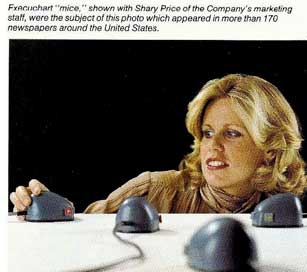
“This philosophy of using physical motions in place of commands will result in the infrequent user being able to use the device and remember how from session to session.
I am convinced that the whole graphing mechanism can be converted to this methodology – it makes the keyboard not only non-essential, but inappropriate – which is what it should be.”
Our developers got the message that I was not going to relent on the vision, and I was not going to accept a compromise solution. Another six months went by and finally I started to see “that’s what I’m talking about …” kind of results.
March 26, 1980 R. Crandall Memo to Comshare Management
Test-Market Observations on Execuchart
“We are definitely at a major departure point in human factors…
“The Mouse: The mouse is going to win. It is rapidly learned and you can use it with great rapidity of motion. In fact, it is so effective that you begin resenting the slowness in the terminal itself and some of the remaining command structure impositions presently placed on the user…”
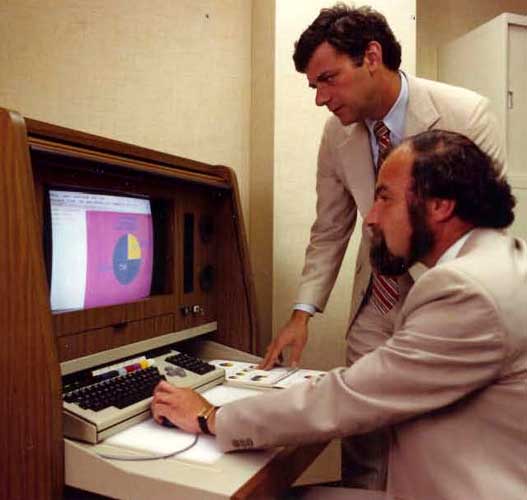
Execuchart was a custom graphics terminal that pre-dated Windows (1980) but was graphical, AND was mouse-driven – by a mouse that we created! It was insane that we would have gone so far into hardware, mice, and creating our own graphical software – there was no way we could keep up with the whole software stack that was involved in the creation of Execuchart – but we got something out the door that got plenty of attention, and it poured fuel on the fire I was trying to start..
However, I still couldn’t find the right technical sponsor internally who was as convinced and as passionate about the project as I was. Fortunately we did have a woman in development, Dorothy Leiffers, who “got it” and who was very good with human factors. She became my “translator” to development – I would draw the pictures and she would work with the developers to get something close to that in software product form. (e.g. see “Calculator” below)
I drew pictures, wrote memos and allocated development funding. I was especially invigorated with the release of the IBM PC – albeit with DOS and not yet with a Windows graphical interface, so we did what Comshare always did – we created our own.
Even looking at the drawing today in 2009 it still looks like a pretty complete vision for an EIS.
If I’d done a financial model of the project and its ongoing costs, the project could never have been justified, but what entrepreneur does that? At the time I couldn’t forecast that IBM or Microsoft would release a viable graphical PC platform and the thought of maintaining our own platform was too daunting to think about. So I didn’t, we just did it.
Eventually, due to our partnership with IBM and System W (our multi-dimensional DSS) as soon as we were briefed about OS/2, we began re-developing the EIS to that platform. In hindsight, that was not the best place for us to be due to the subsequent rise of
Windows 3.0. We did later re-develop onto the Windows platform, but didn’t (couldn’t) drop OS/2, which leads me to another set of observations about multi-platform support that I’ll get to later in this document.
First Commercial Release of Commander EIS
It took us a few more years of development, and the restart on IBM PC’s with OS/2 that finally gave us the local processing computing power for our growing appetite for local storage, code and graphics processing resulting in commercial release of not just a graphics workstation, but a full EIS faithful to my original drawings, thanks to Dorothy.
Touch Screen and a Mouse
We didn’t stop at a mouse-based interface for the EIS which had been so motivating to me from the visit to PARC. We weren’t sure that even a mouse would attract the non-technical executive of that era. So we contracted with an early touch-screen maker to create an overlay for an IBM PC monitor that was touch sensitive, which is no big deal today but was a major, unheard of input method back in 1984. All the graphical screens for Commander were designed so that a finger touch could accomplish the same things as a mouse cursor. It was truly “Information at Your Fingertips” in the truest sense (a campaign we initiated a year before Microsoft’s “Information at Your Fingertips”).
Commander EIS – An Explosive Hit in the Market
Our first ad (above) was a hit, and the growth rocket took off, but not by accident. We also had to innovate in marketing so that the world would know there was something new, it was genuinely for executives (i.e.. the computer uninitiated) and that it would change the way executives managed organizations with “information at their fingertips.” We had limited budget, but it was Norm Neuman, VP of Marketing for Comshare who led our team to achieve global recognition. Norm came up with the catch phrase: “Strategic Information at Your Fingertips” accompanied with the image of a finger touching an icon directly on the display. He played that in many forums repeatedly. It stuck, it surprised and it communicated. He even played it on American Airlines in First Class (reaching executives) in a tremendous campaign. The product was indeed a game changer and an early example of graphical interfaces and touch screens.
I think it is fair to describe what happened over the next several years as a true phenomenon. Certainly it was the most fun highlight of my career.
EIS Market Share Leader
By 1988 Commander EIS was in use in over 170 companies with over 8000 executive users in 10 countries. It had competition, but it had clearly taken a market share lead which we expanded into all of our geographic markets worldwide. It was fascinating to see that this new paradigm of executive use was quite compatible with European executive behaviors.
Once we got to Japan, we learned that the simplified graphical large icons (which we’d sized so that they would work with touch screens in addition to mice) were the opposite of what the Japanese preferred. They actually wanted crowded screens with lots of smaller objects, icons and numbers. All you have to do is look at a Japanese newspaper to see where that comes from.
The press was characterizing Commander as “going beyond user friendly to being user seductive …”
The Harvard Business School
We achieved a major coup when Prof. Warren McFarlan, then Chairman of the Advanced Management Program at the Harvard Business School (and subsequently Chairman of all of Harvard’s Executive Education Programs) decided to do a case study of the use of Commander EIS at Frito-Lay. I met with McFarlan personally, demonstrated the system to him and others at Harvard and he decided to go further to mandate the installation of Commander in the Harvard Advanced Management Program dormitories for visiting executives. He included use of Commander EIS in his curricula.
That is a dream that does not often happen!
We would get dream calls, that we called “bluebirds,” from executives of major companies after attending Harvard’s AMP requesting headquarters visits to Comshare which we readily accommodated. Executives became willing to be publicized as users of Commander and they told their stories readily – exemplified by this Chevron CFO talking about using the EIS to help fend off the hostile takeover bid by Pennzoil.
Massachusetts Institute of Technology Center for Information Systems Research
We had penetrated further into academia with the co-sponsoring of seminars around the country with. Jack Rockart, the Director of CISR (Center for Information Systems Research) at the Sloan School of Management, MIT.
Jack had published and spoken often about the introduction of the concepts of Critical Success Factors into the executive management of enterprises.
His paper in the Harvard Business Review (“The CEO Goes On line”) was surely the seminal academic paper on the subject.
He saw in EIS just the right vehicle for capturing , measuring and following up on CSF’s and so he became a strong advocate – eventually agreeing to serve on the Comshare Board of Directors.
The Comshare/ IBM Deal
Commander EIS market share attracted IBM to expand the prior partnership that had been established with Comshare’s System W multi-dimensional DSS (for the Information Center) a few years earlier – and one of the first such partnerships between IBM and an ISV (Independent Software Vendor). The sponsor in IBM was Bob Berland, who many will remember with great fondness as one of the most liked IBM representatives to the industry ever, right up to his pre-mature death from cancer.
Once again, news of this new partnership gave EIS another boost in the press.
R. Crandall Memos Specifying Additional Exec Applications for Commander EIS
All during this time, I was driving Comshare developers nuts with an outpouring of specifications for additional executive application add-ons to what we’d popularized in the marketplace. I was an unstoppable engine of ideas, but my appetite was a lot bigger than what Comshare could stomach. Some of these did get implemented, but others fell further and further down the queue.
December 14, 1987: Commander’s Alert: Dynamic Exception Reporting
January 22, 1988: Commander Folders
April 8, 1988: Commander Folios
May 27, 1988: Graphical ‘Comparative Analysis’ in ExecuView
June 16, 1988: New Annotation in QuickChart
July 19, 1988: Marketing Requirements for Newswire
November 30, 1988: Exception Reporting
December 16, 1988: RelationalView User Documentation
June 6, 1989: Executive Spreadsheet
August 18, 1989: Newswire Text Search
December 7, 1989: Commander Alerts
Selling EIS
We were pretty convinced we had the better mousetrap (no pun intended) but selling Commander EIS was a whole new experience for a software company. It could not be sold to the MIS leadership; in 1984 they did not believe you could get executives to use computers and they absolutely did not want the exposure and the hassle of servicing high-level, non-technical executives directly. They felt they had enough on their plate with their MIS mission.
We had to get to the absolute top ranks of the Fortune 500 – not an easy task. Clearly it was made easier with the Harvard relationship, the IBM relationship and all the press we were getting. But there was still the issue of how to sell to them once we got their attention. Early in the commercial release of Commander EIS I decided to use it to manage Comshare. I had a granite sign made up with gold inlay letters that said
“Le Patron Mange Ici” which means “the owner eats here” – a sign you see occasionally in a quality restaurant in France. Interestingly we were often complimented for this in the press and we were contrasted with most of the rest of the computer industry that did not use their own products in the way customers did (kind of like the U.S. auto industry).
So we set up a Board room version, a walnut-encased office version in my office and we put out a reward to any sales rep that facilitated a headquarters visit from a prospect where at least one member of the group was senior enough to have his name in the prospect’s annual report! Don Walker, our VP North America and I teamed up. We must have done three such headquarter visits per week for more than three years!
It was exhausting, but exhilarating and our hit rate on closes were amazing.
The Comshare/Dow Jones Deal – an Industry Story
One interesting story that intersected with a major initiative at the trade association level was in 1989 when Adapso, the computer software and services association, and the Information Industry Association (IIA) decided to engage in exploratory talks of merger of the two associations. At that time I had chaired the Strategic Planning Committee of Adapso for about 10 years and in some of our planning sessions we conjectured that there would at some point be a fusion between the software industry and the information content industry, i.e. the newspapers, magazines, and the computer data base companies that comprised the IIA. I was a representative from the Adapso side and Carl Valente of Dow Jones was the lead from IIA. We both loved the idea and became advocates within our respective trade organizations, which even led to a combined meeting of the two groups. It didn’t go well.
The biggest problem was that the IIA folks mainly thought of themselves as print media and had nothing to do with computer services and software – which in retrospect one might conclude was not the best strategic view of what would eventually happen to print media with the advent of the Internet.
Carl and I were frustrated with the attitudes and the views that there was no reason for a software company and an information company to partner or rub shoulders in any way. We decided to create a partnership between Dow Jones News Retrieval and Comshare, specifically focused on our creating a News application for Commander EIS.
I was very excited about that prospect and immediately set about the task of designing what the News application would look like on screen. I also moved the project up the priority list and we got it done – Commander EIS Newswire. We developed it, we released it and customers loved it – even though they had to execute an additional fee-based subscription with Dow Jones News Retrieval not unlike the news subscriptions one finds on the Internet today.
What Were the Bad Decisions in the EIS Project?
I’m not one to dwell on the negatives, but the worst decision I made during Comshare’s EIS era was highly negatively impactful on our ability to keep up with customer demands and my own prolific torrent of new product ideas. It is a lesson learned by many software vendors I’m sure – and is undoubtedly a continuing lesson today: I got sucked in by customer and partner pressure to support all three PC platforms in that day – Windows, OS/2 and the Apple Macintosh.
We did it, but at a cost that I did not appreciate at the time. In retrospect I believe multi-platform support was the biggest cause in our not having sufficient funding or development resource to progress the architecture and advance the features of the product. Simply, here’s how it happened.
1. When we started the project there was no Windows, nor Apple Mac nor any graphical platform, so we did our own in DOS – Benefit: We were early to market.
2. Our partnership with IBM had a pre-condition that we develop to Presentation Manager on OS/2. My judgment was that the IBM association in the market would outweigh the development costs to support OS/2. In hindsight, while IBM did help us greatly with System W earlier, they had no pull with high-level executives and we didn’t need them. Supporting OS/2 dragged on our resources.
3. Then five major clients ganged up on us to support the Apple Macintosh ( I remember Dupont was one of them). I resisted at first and then succumbed on the theory that you’re supposed to do what your customers want. It turns out Apple itself was cleverly behind each one of them – instead of approaching us directly they did it through our customers. I caved and we went for it – at a much larger expense in opportunity cost than I appreciated at the time.
Oh, we loved the attention showered on us by Apple but in hindsight, the revenue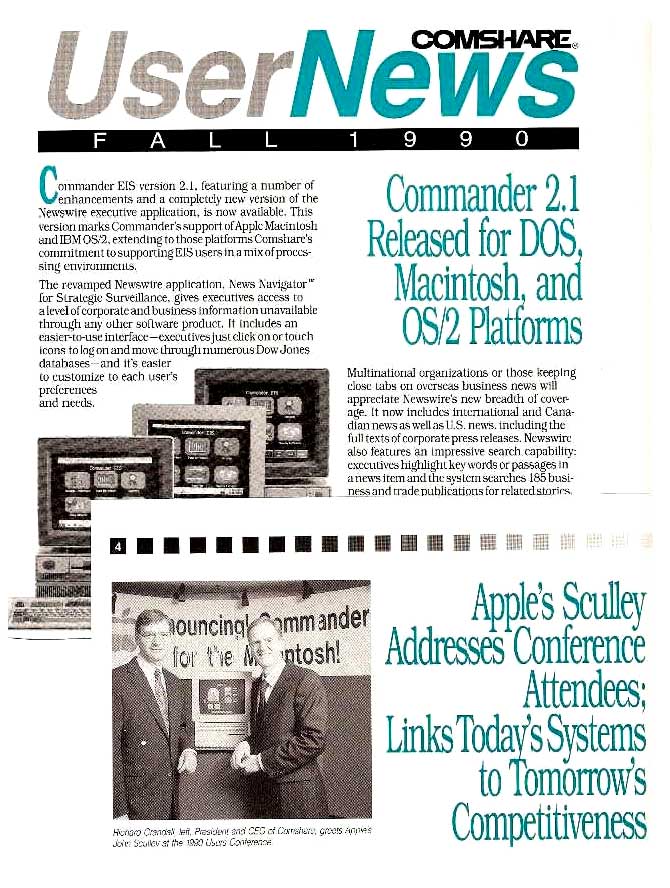
we got came no where near even the direct cost, and the indirect cost was a disaster. My message to
any software CEO facing similar decisions today is to spend lots of time and analysis on the merits, the market size, the impact on precious resources, cycle times, support costs and all the many factors and complexities of multi-platform support.
While it sounds good, feels good on day of announcement and you then get indigestion big time.
Wrap-up: Wither Goest EIS?
I retired from Comshare in 1994. Certainly today one might argue that EIS’s per se are not needed, everyone is computer literate with mouse-based graphical interfaces, touch-screen based smart phones and keyboard-based email and social networking systems. However I would still argue that if you look at the convenience of where EIS’s got to and were headed – the ease with which you could drill down into the numbers, chart the trends and access public information sources and generate alerts – I contend that something similar would still win the favor of high-level executives today.
EIS’s as packaged software products eventually fell by the wayside after a great 10 – 12 year run. I wouldn’t be surprised if someone brings them back – and makes another generation of success of it.



